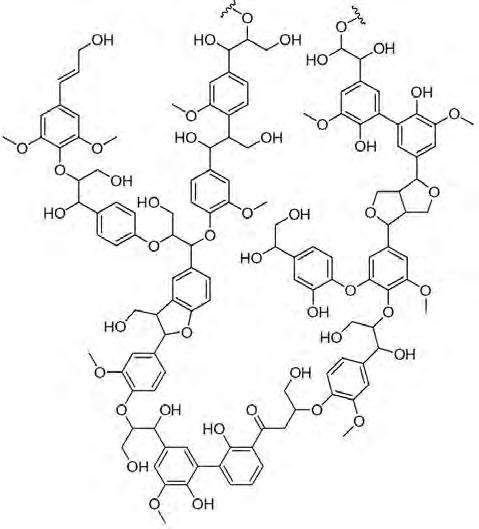
22 minute read
European project LIBERATE “Lignin biorefinery approach using electrochemical flow”: Towards the electrification of chemical biorefineries
European project LIBERATE “Lignin biorefinery approach using electrochemical flow”: Towards the electrification of chemical biorefineries Projecte europeu LIBERATE «Enfocament a la biorefineria de lignina mitjançant flux electroquímic»: cap a l’electrificació de les biorefineries químiques
Carlos Troyano, Òscar Alonso, Oriol Angurell, Marc Belenguer, Marcel Boerrigter, Miguel González, Sonia Matencio i Ángel M. Valdivielso Centre Tecnològic LEITAT
Abstract: The European project LIBERATE aims to deliver a pilot-scale electrochemical plant to demonstrate the commercial opportunities of converting low-cost lignin feedstocks into high-value biosustainable chemicals. The project is focused on obtaining added-value products from different types of lignin and cyclohexanols coming from wood and straw. This article explains how the project is organised to achieve this goal, with the essential contributions of many academic and industrial disciplines from different countries.
Keywords: Lignin, electrochemistry, flow chemistry, biorefinery.
Resum: El projecte europeu LIBERATE té com a objectiu principal dissenyar una planta electroquímica a escala pilot per demostrar les oportunitats comercials de transformar matèries primeres de lignina de baix cost en productes químics biosostenibles d’alt valor industrial. Per tal d’obtenir productes útils de valor afegit, el projecte té en compte diferents tipus de lignina i ciclohexanols provinents de la fusta i de la palla. En aquest article s’explica com està organitzat el projecte a fi d’assolir l’objectiu en qüestió, per a la qual cosa és fonamental l’aportació de moltes disciplines acadèmiques i industrials de diferents països. Paraules clau: Lignina, electroquímica, química de flux, biorefineria.
Introduction
Lignin is a complex organic polymer which forms part of the lignocellulosic material of most plants (figure 1). Lignocellulosic biopolymers strengthen the cell wall of plants and consist of three main components: cellulose (38-50 %) and hemicellulose (23-32 %) form a framework in which lignin is incorporated as a kind of connector, thus solidifying the cell wall [1]. Lignin is mainly concentrated in the cell walls of wood and makes up about 20-35 % of the mass of every tree or plant. After cellulose, it is the most renewable organic source on Earth. The total lignin present in the biosphere exceeds 300 billion tonnes and annually increases by around 20 billion tonnes.
This organic polymer lacks a well-defined structure. Lignin has unique properties, including its highly aromatic nature
Contact address: Carlos Troyano Centre Tecnològic LEITAT Districte 22@. C. de Pallars, 179-185. 08005 Barcelona (Spain) Tel.: +34 937 882 300. Fax: +34 937 891 906 E-mail: ctroyano@leitat.org
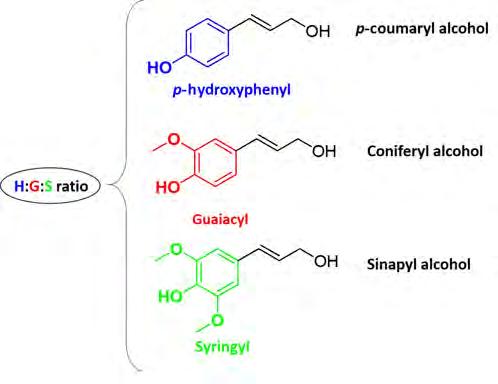
Figure 2. The three common monolignol building blocks of lignin. Source: Prepared by the authors.
and lower oxygen content compared to polysaccharides, making it a highly interesting biopolymer to be converted into renewable chemical building blocks and related fuels and materials. Even though it is a complex, irregular and randomly cross-linked phenolic polymer, the various types of lignin can be differentiated by considering their composition. Overall, lignin is composed of three different primary phenylpropane monomer or monolignol units of p-coumaryl alcohol (p-hydroxyphenyl or H unit), coniferyl alcohol (guaiacyl or G unit) and sinapyl alcohol (syringyl or S unit) [2] (figure 2). The monolignol unit has hydroxy- (–OH) and methoxy- (–OCH3) substituted phenylpropane units which are joined through several dissimilar linkages to form a high molecular weight structure.
Lignin can have a variety of structures and compositions, depending on the specific plant or tree species, the season, the climate and the plant age. Moreover, the composition of lignin will closely depend on the plant species, in terms of both H/G/S composition and the relative abundance of the chemical linkages in the polymer (figure 3).
As commented above, lignin is found in lignocellulosic material along with cellulose and hemicellulose. The process applied to the biomass to separate lignin from other components causes a significant alteration of its molecular structure, thus leading to “technical lignins”. Consequently, the characteristics of the technical lignin are different as regards molecular weight, water solubility, degree of contamination, extent of condensation and functional group decoration of the macromolecule. Several types of technical lignins are obtained, depending on the pre-treatment process used. For instance, kraft lignin is obtained as a by-product of paper production (treatment of wood chips with a hot mixture of water, sodium hydroxide [NaOH] and sodium sulphide [Na2S]),
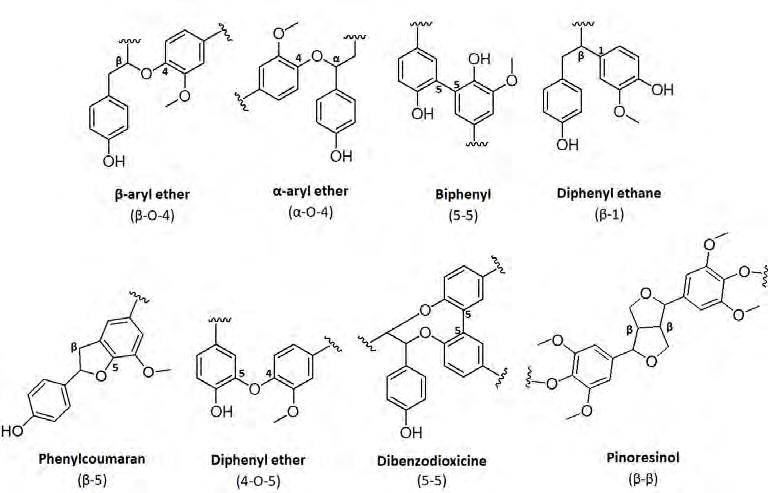
incorporating covalently into its structure sulphur species that can have consequences for further valorisation. However, high-purity sulphur-free organosolv lignin is obtained by solvent extraction under mild conditions at lab scale. The features of some typical lignins are briefly listed in table 1.
Table 1. Features of several types of lignin. Adapted from [4].
Type of lignin Pre-treatment chemistry
Lignosulphonates Acid
Separation method Sulphur content
Scale of production
Ultrafiltration High Industrial
Kraft
Soda Organosolv Alkaline Precipitation Moderate Industrial
Alkaline Acid Precipitation Extraction Free Free Industrial Pilot/lab
The use of lignin as biofuels, chemicals and a food source in future biorefineries is a topic of growing scientific interest [5]. At present, lignin is primarily used for energy generation but it is also used for dispersants, emulsifiers, plastics/polymers, aromatics or stiffness enhancers in board products. All current pre-treatment methods, however, lead to technical lignins in which the molecular structure is significantly altered with respect to native lignin, and which will be chemically more recalcitrant to depolymerisation and valorisation. Therefore, it is necessary to work towards achieving lignin valorisation with the best-suited lignin structure for chemical conversion to obtain the targeted product.
Reported traditional methods of depolymerisation can mainly be divided into hydrolysis reactions, catalytic reductions and catalytic oxidation reactions. Hydrolysis in alkaline aqueous solution can generate phenol derivates but the yield is as low as <10 % [6]. Catalytic reductions disrupt the structure and remove chemical functionalities from lignin to produce cyclic hydrocarbons and aromatics with a yield of up to 6 % at high temperatures [7]. Catalytic oxidation reactions tend to form aromatic compounds with additional functionality. As an example, lignosulphonate oxidation leads to the basic chemical vanillin [8], which is the only commercialised copper catalytic oxidation process, known as the Borregaard process (around 2 %) [9]. Thus, lignin depolymerisation into value-added aromatic products under unconventional methods such as electrochemistry, microwave chemistry, mechanochemistry or sonochemistry would greatly benefit both the fine chemical industry and green renewable chemistry [10]. In general, these processes are a promising environmentally friendly alternative for lignin depolymerisation under milder conditions.
LIBERATE concept: Flow electrochemistry from lab scale to pilot plant
The European LIBERATE project has as its main objective the delivery of a pilot-scale electrochemical plant to demonstrate the commercial possibilities of converting low-cost lignin feedstocks into high-value biosustainable chemicals (figure 4), overcoming the technical developments, pilot line scale-up and commercial exploitation barriers of the next generation of biorefineries. As a key point in this respect, the system will be modelled and physically integrated with renewable energy sources to deliver a process that is capable of synthesising chemicals with nearly zero CO2 emissions. Moreover, the renewable energy integration will open up new business models for biorefinery operators to utilise peak renewable energy at discounted rates.
Thus, LIBERATE will provide the following benefits: (a) an electrochemical depolymerisation of kraft lignin to synthesise vanillin with a 7 % yield since synthetic vanillin is now used more often than natural vanilla extract as a flavouring agent in foods, beverages and pharmaceuticals; (b) an electrochemical depolymerisation of organosolv lignin to synthesise mixed phenolic derivate oligomers with a yield of >35 %, which have a wide range of uses, for instance they can be used as antioxi-
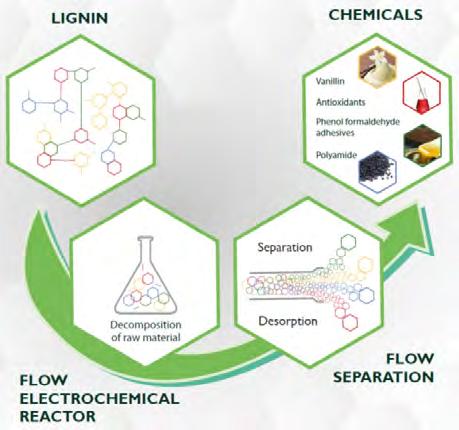
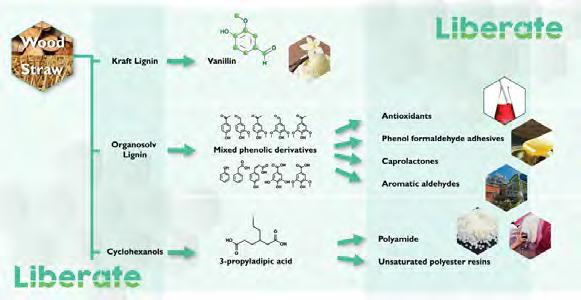
Figure 5. Overview of the main processes carried out in LIBERATE to obtain useful chemicals from different types of lignin and cyclohexanols. Source: Prepared by the authors.
dants, adhesives and aromatic aldehydes; (c) an electrochemical oxidation of biosustainable cyclohexanol (obtained from lignin) to synthesise propyl adipic acid with a yield of up to 80%, which can be used to prepare new polyamides and unsaturated polyester with new and interesting applications (figure 5). In addition, it will provide a biorefinery process capable of accommodating fluctuations in renewable energy sources without loss of efficiency (providing a 95% improvement in the energy efficiency of the process and a 350% improvement in resource energy), with the capability of producing 29 times less CO2 than the conventional petrochemical alternatives.
In this way, highly efficient and selective anodic electrochemical oxidation will be applied to the depolymerisation of lignin and the synthesis of propyl adipic acid from cyclohexanol to provide a range of biosustainable feedstocks for drop-in replacements or for superior product performance.
Implementation of LIBERATE
To achieve the above-mentioned objectives, the contribution of many disciplines, both in academia and industry, is required. For this reason, LIBERATE represents a powerhouse consortium, including three major multinational chemical companies (Evonik, Perstorp and Oxiris), SMEs (Chimar, Megara, NX Filtration, Condias, Enso Innovation, Idener and Gate to Growth), four internationally regarded research and technology organisations (TNO, Fraunhofer, LEITAT and Sintef), and leading European universities (Johannes Gutenberg-Universität Mainz and Universidad de Alicante) (figure 6). This project is coordinated by LEITAT and has a total budget of €10,047,735, with funding from the European Union’s Horizon 2020 research and innovation programme (€8,763,489) under grant agreement no. 820735.
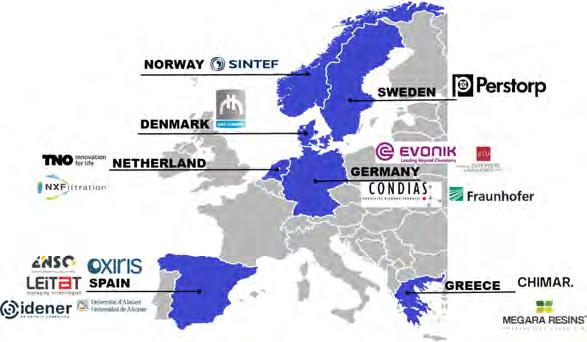
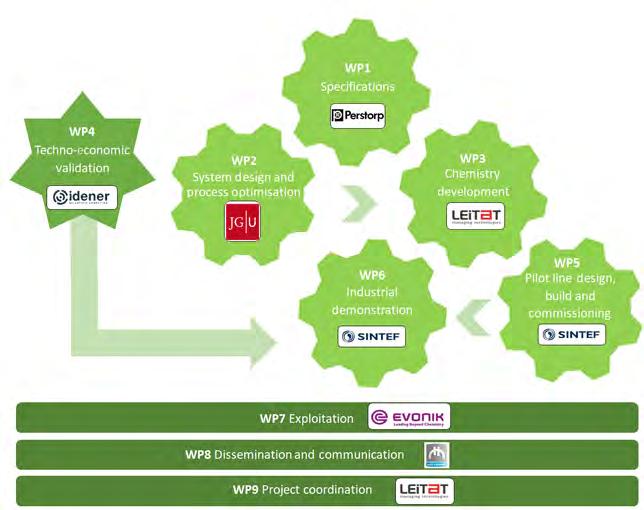
Figure 7. Interaction among the different WPs of the LIBERATE project. Source: Prepared by the authors.
The work plan to achieve the project’s objectives is organised in nine work packages (WPs), which are related to each other as shown in figure 7.
WP1. Specifications
The main objective of this work package is to finalise and agree on the system requirements for processing lignin. Consequently, it will comprise the selection of the starting materials, including such aspects as the origin of the lignin, types of lignin, solvents and pre-treatments. The minimum components of the final system will be also described, together with its main characteristics, parameters, energy requirements, final product targets and the specifications of the pilot plant.
WP2. System design and process optimisation
This work package is focused on carrying out lab scale tests of the designed reactors and their optimisation. Moreover, it will determine the most suitable lignin sources and the pretreatment for the individual electro-conversion, identifying appropriate materials, conditions, and design (figure 8). Consequently, the lignin samples produced from the biomass
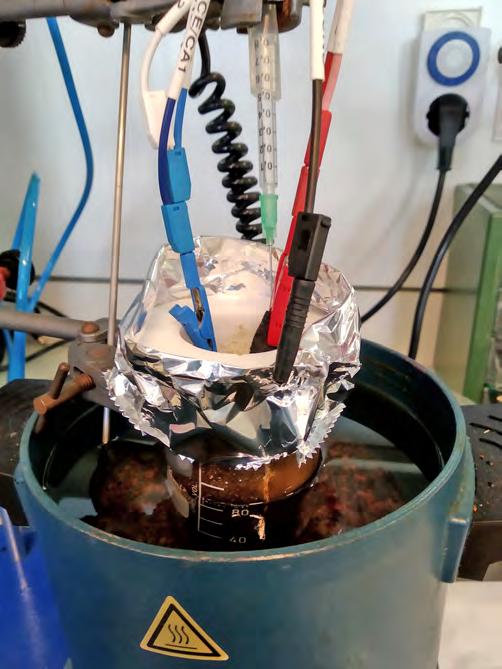
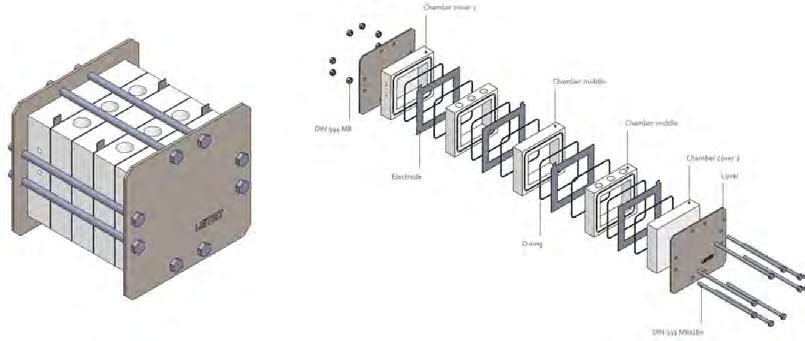
Figure 9. Electrochemical reactor design by LEITAT. Source: Prepared by the authors.
feedstocks and pre-treatment processes selected in WP1 and the impact on the lignin composition, as well as the relevant physical properties for the flow reactor, will be investigated.
The reactor design will be implemented at lab scale as a prototype and tested to evaluate its performance. The laboratory reactors will demonstrate their performance by measuring different parameters to validate the design and to establish valid cost-efficient work-up strategies (figure 9).
WP3. Chemistry development
The implementation of the LIBERATE processes into a lab flow system, including electrochemical reactors and downstream to validate the technologies before the pilot demonstration, will be carried out in this WP. Specifically, in this work package we will: (a) obtain a process model capable of predicting mass transfer, flow rate and outputs that occur within the reactor; (b) manufacture the electrodes with the required performance (additive manufacturing techniques will be considered to produce electrodes allowing geometries and surfaces that are impossible to achieve by traditional techniques) (figure 10); and (c) select and evaluate the purification and separation techniques from WP2 under the final system conditions.
WP4. Techno-economic validation
The main objectives of this work package are to optimise the integration of the LIBERATE system with renewable energy sources and to prove the viability of the technology for its implementation in different scenarios. In this respect, the availability of renewable resources at the facility location, the profile of the use in biomass processing, and the renewable facilities (if any) which are currently installed are factors that will be considered in the model of the integrated system.
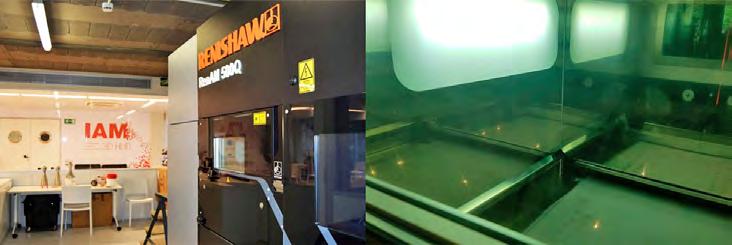
Likewise, the environmental performance of the defined test cases will be quantified and analysed based on the life cycle assessment (LCA) methodology. LCA is considered the best framework for assessing the potential environmental impacts of the products. This study will examine in depth every stage of the whole system developed in LIBERATE.
WP5. Pilot line design, build and commissioning
During WP5, the partners will work on the design, construction and demonstration of a continuous flow system pilot at demo scale at TRL6 with direct coupling to photovoltaic panels. The work will be based on the specifications defined in WP1 and the requirements for end-product validation defined in WP4. Critical technical input on reactor design and downstream separation design will be obtained from the work carried out in WP2 and WP3 (figure 11).
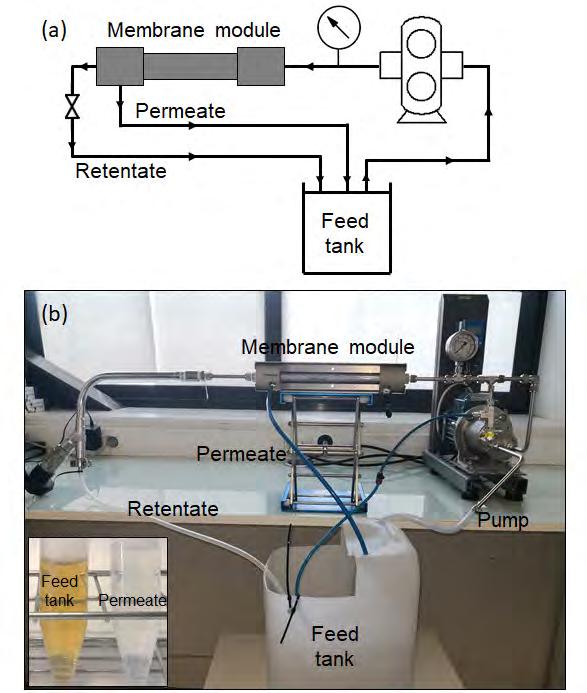
Figure 11. (a) Schematic representation and (b) photograph of the set-up employed for the membrane evaluation in total recycle mode carried out at LEITAT with membrane modules from NX Filtration. Source: Prepared by the authors.
Consequently, depending on the method chosen by the consortium to deliver the most promising lignin quality, organosolv lignin will be provided (figure 12). Trials will be embedded within the single integrated piloting facility, including all downstream activities for provision of sufficient data to LCA.
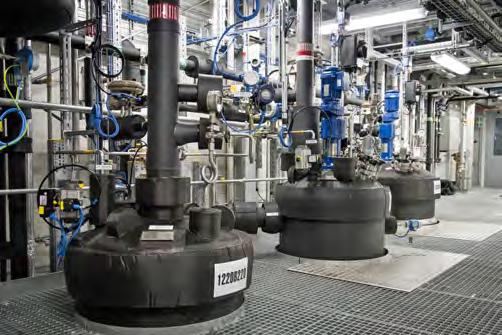
Figure 12. Pilot plant from Fraunhofer CBP (Leuna, Germany) to produce organosolv lignin. Source: Photo from the authors.
WP6. Industrial demonstration
In this work package, the LIBERATE technology will be demonstrated over a period of 9-12 months at Sintef in Trondheim, Norway (figure 13). The commissioning of the entire system and its subsequent demonstration will be performed continuously to minimise costs. The following factors will be considered: (a) the economic validation of the LIBERATE process, including OPEX and CAPEX; (b) an LCA (already explained in WP4) of the completed process, including how LIBERATE meets the impact requirements; and (c) production and optimisation of end products for validation.
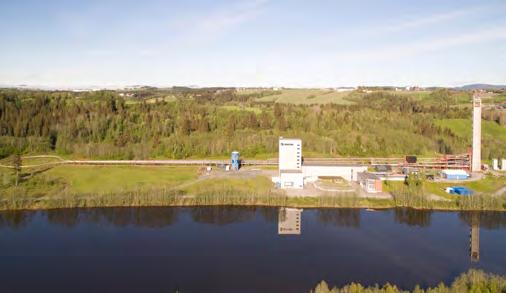
Figure 13. Test site at Trondheim, Norway (Sintef), where the future pilot plant will be installed and commissioned. Source: Photo from the authors.
WP7. Exploitation
As a project with a high TRL, it is necessary to develop a viable business plan to maximise the chances of post-project com-
mercial success and to assure that the project’s intellectual property and its results are adequately protected, maintaining an exploitation risk register for review at meetings held every 6 months. The ultimate commercial exploitation of the results will be of the utmost importance throughout the duration of the project to ensure the maximum impact both inside and outside the project consortium.
WP8. Dissemination and communication
This work package is responsible for defining measures to ensure that the project’s results are communicated and disseminated to society (figure 14). In this respect, the tasks of this work package are aimed to: (a) assure that there is ongoing communication between the consortium and the public; (b) support knowledge exchange between the partners through workshops with internal/external groups; (c) optimise integration effects and collaboration by means of training activities; and (d) produce an education package which will easily be integrated into existing curricula and modules for undergraduate level programmes, master’s programmes and short courses.

WP9. Project coordination
Lastly, this work package comprises the development of an appropriate management framework so that all knowledge is created and disseminated in a coordinated and coherent manner. All technical activities, legal aspects and other issues are managed to a high standard. It is important to ensure that all project results are formulated and compiled in a form that can be protected by the most appropriate legally enforceable protection method. This WP is also responsible for the control and management of scientific knowledge transfer from the research consortium members to enable this technology to be applied in new markets and applications. In addition, the benefits of the developed technology and knowledge should be communicated beyond the consortium to other potential industrial communities, and the social economic impact of the generated scientific knowledge and technology should be suitably managed and accessed.
Progress beyond the state of the art
In the first 18 months of project, LIBERATE achieved the following results: (a) batch production of vanillin from commercial kraft lignin with a yield of up to 6 % wt (at least three times higher than the current commercial process) and 91 % effectiveness (compared to the highest theoretically calculated yield); (b) production of propyl adipic acid with a yield of about 60 %, in which several electrode materials and geometries were evaluated using different techniques, including traditional manufacturing, additive manufacturing and chemical vapor deposition; in this respect, the transfer of both reactions to a larger electrode surface, i.e., a larger area, was established without significant changes regarding yield or selectivity; (c) different reactor approaches were designed, including a filter-press reactor and a tubular reactor to transfer the reactions from a batch system to a flow system. These reactors are in the process of manufacture and testing with the respective procedures to validate and select the best options for implementation (figure 15); and (d) lab tests were carried out, using different single module filtration to purify
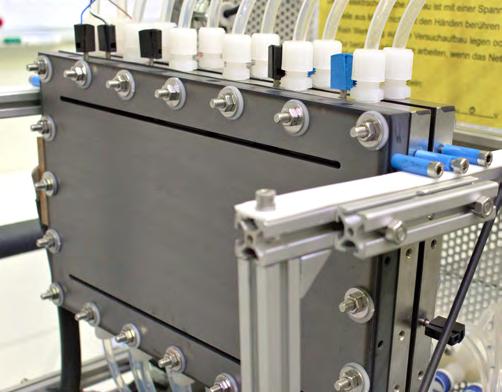
Figure 15. Flow electrochemical cell from Condias. Source: Photo from the authors.
the final compounds, obtaining retentions of around 85 % for lignin and of up to 75 % for different phenolic compounds. These modules could be coupled with a flow separation system using ion exchange resins that, by tuning the solvent conditions, would allow nearly all the mono-aromatic phenols to be recovered.
Regarding the initial lignins, LIBERATE produced different organosolv lignins from softwood, hardwood and herbaceous biomass under various fractionation conditions and staged lignin precipitation for improving the electrochemical depolymerisation efficiency (figure 16). In general, the validation of fractionation conditions of the electrochemical lignin depolymerisation behaviour revealed differences in depolymerisation rates, although no lignin type was found to significantly outperform the others. In the course of the project, a total of 8 exploitable results have been identified and a more detailed business plan will be developed for each of the results as the project progresses.
Conclusions
In conclusion, the overall concept of the LIBERATE project is to extract valuable chemical products from an existing waste stream such as lignin. By the end of 2022, the project will deliver a fully characterised continuous electrochemistry-based biorefinery system for lignin valorisation. The system will use kraft and organosolv lignin as feedstocks along with cyclohexanols to generate vanillin, biogenic adipic acid analogues and biophenols, respectively, which are of high value and high industrial interest. The low heat and energy input requirements of this continuous process readily enable its integration with renewable energy generators. Thus, lignin depolymerisation into value-added aromatic products under mild conditions will greatly benefit both the value-added fine chemical industry and the green/renewable chemistry sector, substituting the current conventional methods.
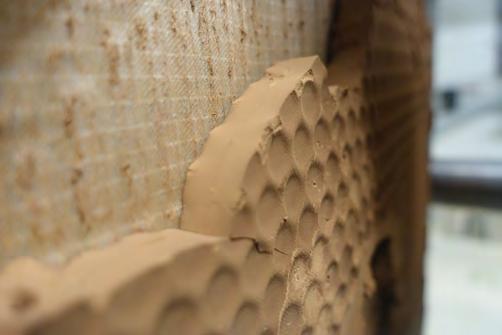
Figure 16. Organosolv lignin produced for LIBERATE in the pilot plant at Fraunhofer CBP. Source: Photo from the authors.
Acknowledgment
This project has received funding from the European Union’s Horizon 2020 research and innovation programme under grant agreement no. 820735. The authors thank the partners Condias, Fraunhofer CPB and Sintef for sharing images for this article.
References
[1] cHáveZ-siFontes, m.; domine, m. e. “Lignina, estructura y aplicaciones: Métodos de despolimerización para la obtención de derivados aromáticos de interés industrial”. Av. Cien. Ing., 4 (4) (2013), 15-46. [2] Ponnusamy, v. k.; dinH, d. n.; dHarmaraJa, J.; sHoBana, s.; saratale, r. g.; cHang, s. W.; kumar, g. “A review on lignin structure, pretreatments, fermentation reactions and biorefinery potential”. Bio. Tech., 271 (2019), 462-472. [3] rinaldi, r.; JastrZeBski, r.; clougH, t. m.; ralPH, J.; kennema, m.; BruiJnincX, a. c. P.; WeckHuysen, m. B. “Paving the way for
lignin valorisation: Recent advances in bioengineering, biorefining and catalysis”. Angew. Chem. Int., 55 (2016), 81648215. [4] mood, s. H.; golFesHan, a. H.; taBataBaei, m.; JouZani, g. s.; naJaFi, g. H.; gHolami, m.; ardJmand, m. “Lignocellulosic biomass to bioethanol, a comprehensive review with a focus on pretreatment”. Renew. Sustain. Energy Rev., 27 (2013), 7793. [5] villanueva, g. r. a.; césPedes, g.; martíneZ, a. c.; celia, a.; carvaJal, a.; yailet; ramos, v. g. “Lignin valorization in biorefinery concept (I)”. Centro Azúcar, 47 (2020), 95-105. [6] ZHu, H.; Wang, l.; cHeng, y.; li, g.; li, H.; tang, y.; Wan, P. “Electrochemical depolymerization of lignin into renewable aromatic compounds in a non-diaphragm electrolytic cell”. RSC Adv., 4 (2014), 29917-29924. [7] ZakZeski, J.; Jongerius, a. l.; BruiJnincX, P. c. a.; WeckHuysen, B. m. “Catalytic lignin valorization process for the production of aromatic chemicals and hydrogen”. ChemSusChem, 5 (2012), 1602-1609. [8] BJørsvik, H.; minisci, F. “Fine chemicals from lignosulfonates. 1. Synthesis of vanillin by oxidation of lignosulfonates”. Org. Process Res. Dev., 3 (1999), 330-340. [9] TJosås, F. Utilisation of waste stream [on line]. BioRefine2G workshop 2017. <https://www.biorefine2g.eu/images/ WS-Stockholm/2-BioREFINE-2G_Workshop_EUBCE2017 _Stockholm_Tjosas_Borregaard_web.pdf>. [10] BeHling, r.; valange, s.; cHatel, g. “Heterogeneous catalytic oxidation for lignin valorization into valuable chemicals: What results? What limitations? What trends?”. Green Chem., 18 (2016), 1839-1854.
C. Troyano
M. Boerrigter Ò. Alonso
M. González O. Angurell
S. Matencio M. Belenguer
Á. M. Valdivielso
Carlos Troyano holds a Chemistry degree (2017) and Master’s degree in Organic Chemistry (2018) from the Universitat de Barcelona (UB). During the academic period, his research was focused on the synthesis, characterisation and study of new water-soluble porphyrins. He is currently a junior researcher in the Applied Chemistry & Materials Department (Synthesis Group) at LEITAT Technological Center, participating in national, industrial and European projects related to organic chemistry. He has also acquired expertise in such fields as general organic synthesis, electrochemistry, sonochemistry, sol-gel technology and flow chemistry.
Òscar Alonso is an industrial engineer specialised in Mechanics who graduated at the Universitat Politècnica de Catalunya (final degree project at the University of California, Irvine). During the study period, he was trained in computer aided design (CAD tools) with CATIA and SolidWorks, and in automotive technologies and manufacturing processes. Òscar is the Additive Manufacturing and 3D Printing area manager of the Energy and Engineering Department at LEITAT, coordinating the team and participating in R & D proposals and projects, industrial innovation and new advanced applications. His expertise is related to the fields of device design and development, mechanical design and calculation, reverse engineering, production and inspection processes in the automotive industry, and manufacturing technologies, with special emphasis on additive manufacturing and 3D printing.
Oriol Angurell graduated in Chemistry (2019) and obtained a Master’s degree in Organic Chemistry (2020) at the Universitat de Barcelona (UB). During his academic period, he investigated new synthetic strategies using hypervalent iodine in IQAC. He made a stay in the Instituto de Biomedicina de Sevilla (IBiS), measuring the glycolytic rate in the mouse brain. He returned to IQAC to carry out his master’s degree project on synthetising molecules related to bacterial quorum sensing. He is currently working at LEITAT Technological Center as a junior researcher in the Applied Chemistry & Materials Department on R & D projects. He participates in national, industrial, and European projects related to organic chemistry. He has acquired experience in flow chemistry, electrochemistry, sonochemistry and synthesis of different industrial products at laboratory scale.
Marc Belenguer graduated from the Universitat de Barcelona (UB) in 2007. He continued his training with master’s and doctoral studies in the Laboratory of Electrodeposition and Corrosion (ElectroDep) at the Universitat de Barcelona, working with synthesis of Ni composites and synthesis of metal nanowires in alumina substrate for different uses such as biological sensors. In 2014 he moved to the École Nationale d’Ingenieurs de Tunis (ENIT), where his main concern was sol-gel coatings applying electrochemistry conditions. After obtaining his PhD in 2016, he started to work in an industrial tender assessment, involving characterisation, development, production in small-medium scale and up-scaling of coatings as per customer requirements. Now he is an R & D researcher in the Energy Storage Group of LEITAT Technological Center, working on industrial offers and participating in national and European projects for the development of energy storage devices. He has worked on printed devices and lithium-ion batteries for energy storage.
Marcel Boerrigter is a senior researcher at LEITAT. He has a Bachelor of Science degree in Chemistry from the Hogeschool Enschede (Saxion University of Applied Sciences), Enschede, The Netherlands (1996). From 1997 to 2012, he worked at the European Membrane Institute (EMI) in the Netherlands. He performed confidential contract research for companies/institutes worldwide and research in various European projects in the field of membrane science and technology. Since October 2012, he has been a senior researcher leading the Membrane Unit at LEITAT Technological Center on the investigation and development of new membranes combined with nanomaterials for gas and water purification for various European and national projects. His main competences involve membrane manufacture (flat sheet, hollow fibre and nanofibre) development and characterisation for microfiltration (MF), ultrafiltration (UF), nanofiltration (NF), reverse osmosis (RO), pressure retarded osmosis (PRO), pervaporation, gas separation and electrodialysis, among other applications.
Miguel González holds a Master’s degree in User Experience at La Salle–Universitat Ramon Llull and a Postgraduate degree in advanced CAD at Universitat Politècnica de Catalunya. He is a graduate in Engineering in Industrial Design at Elisava School of Design and Engineering of Barcelona. Specialised in computer aided design (CAD) and materials, he is a technical engineer of public works (specialty in civil constructions) at the Universidad de Salamanca. He is currently working at LEITAT Technological Center on R & D & I projects as a product design engineer in the Technology Integration and Product Development Department. His expertise is related to product design and development, design techniques and processes, materials, manufacturing processes, prototyping and interface design, as well as CAD, rendering and materials software.
Sonia Matencio holds a degree in Chemistry (2009) and a PhD in Nanoscience (2015) from the Universitat de Barcelona. She is a researcher at LEITAT Technological Center in the Applied Chemistry and Materials Department, where she is involved in national and international projects in the field of membrane science and technology. Her research is focused on the development of polymeric nanofibres by electrospinning for air and water pollution, liquid membranes for metal separation, membranes for separation of lignin and other basic chemicals, and modifications of nanocellulose for water purification.
Ángel M. Valdivielso holds a PhD in Chemistry (2012, Universidad Complutense de Madrid). He is a senior researcher at LEITAT in the Applied Chemistry and Materials Department, in charge of the Organic Chemistry Unit. His research career has been focused on organic chemistry in different fields such as synthetic organic chemistry, medicinal chemistry and supramolecular chemistry. His research currently comprises different lines in the organic synthesis area, including custom synthesis, flow chemistry and unconventional synthetic methods (mainly electrosynthesis, microwave and ultrasound) and their application to industrial services. Ángel has been involved in and coordinated several European (FP7 and H20202 framework), national (basic and applied research) and industrial projects. He has also participated in several conferences, published papers in international scientific journals, and obtained patents in the fields of organic chemistry and material science.









